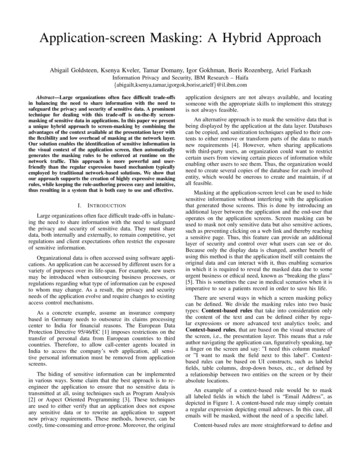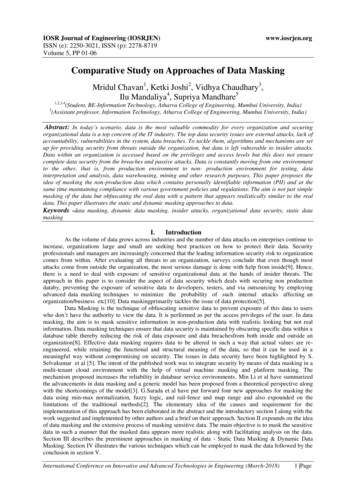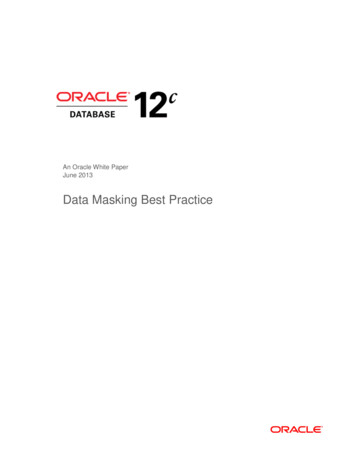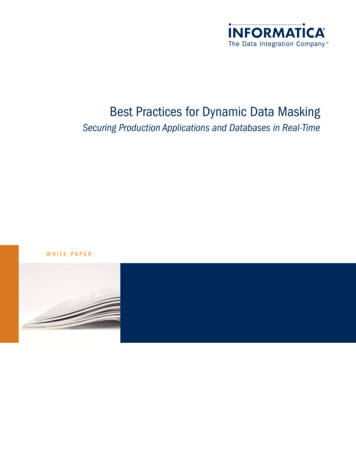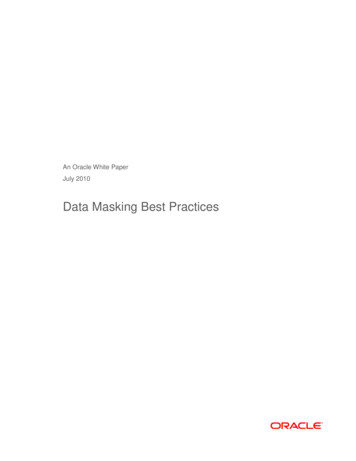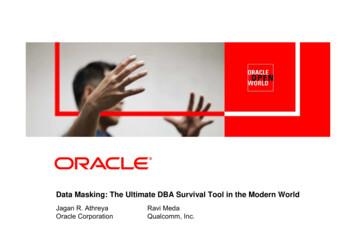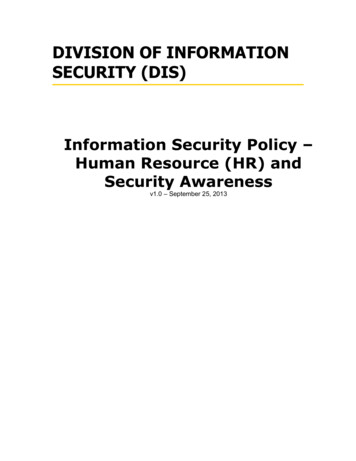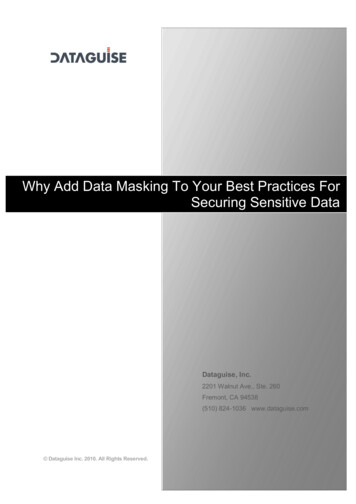
Transcription
Why Add Data Masking To Your Best Practices ForSecuring Sensitive DataDataguise, Inc.2201 Walnut Ave., Ste. 260Fremont, CA 94538(510) 824-1036 www.dataguise.com Dataguise Inc. 2010. All Rights Reserved.
Why Add Data Masking To Your Best Practices For Securing Sensitive DataIntroductionDatabases are critical assets for all organizations. No matter if the entity is big or small,databases are an essential part of any business operation. Most enterprises store sensitive datasuch as credit card numbers, social security numbers, company confidential data and otherdata, which make them a target for attacks. A database is like a bank vault that stores money.Databases are critical, data security is a high priority.Today database attacks, both internal and external, are on the rise. More than 70 percent of allattacks on databases are internal, making them very difficult to detect and curb. Analyst reportsindicate that more than 240 million customer records have been compromised to date. Largecompanies that range from financial institutions, retailers, and insurance companies toprestigious universities regularly suffer negative headlines proclaiming data theft or loss. Suchattacks are likely to grow even more in the future unless enterprises take stronger data securitymeasures to protect their databases.A data security breach can have a severe impact on any organization such as, lawsuits, legalfines, negative brand recognition and decline in stock prices. Mitigating risk is critical to anybusiness. Just like car insurance you may never need it but if you are in an accident you musthave it. According to leading industry analyst firms, the cost of a breach is anywhere betweenUS 50 to 300 per record, which can collectively add-up to millions of dollars.The Current Problem: Data is often not protected in non-production environmentsMost enterprises secure production databases when dealing with sensitive data, but only a fewsecure such data in non-production environments such as test, development and Quality &Assurance (QA). Regardless of where the data is stored, production or non-production, datasecurity remains equally important. The value of such data remains the same. Unlikeconfidential hard copy paper digital information can be duplicated and quadrupled easily, andthen rapidly deployed to platforms such as test and development, making the data vulnerable.To test any business application data is essential. In most cases testing data comes fromproduction environments, making test databases vulnerable to exposure to both internalprivileged users and external hackers. Non-production environments such as test,development, QA and staging databases are often given a lower priority when it comes tosecurity.Multiple copies of production data exists in non -production environments. On averagefive copies exist for each production database to support test, development, QA, migration andstaging environments (See Figure 1). More copies of production data means increased securityrisk. Dataguise inc. 2010. All rights reserved.Page 2 of 8
Why Add Data Masking To Your Best Practices For Securing Sensitive DataFigure 1. Typical Non-ProductionProduction EnvironmentNew user accounts created without valid authorization . When a non-productionproduction environment isset-upup to be accessed by testers, developers, and other IT personnel the new user accounts aretypically created with full access to all data. However, the same data in a productionenvironment often has a high level of data access control.Data is often extracted from non-productionnon production databases to other smaller data repositories.Based on requests by customers and other 3rd party entities, many developers and testersextract company data from non-productionnon production environments and output them to files and desktops.This practice not only increases data security challenges, but also makes data vulnerable tounintended exposure.Regulatory Compliance Continues To Pressure EnterprisesOver the past few years, various regulatory compliances such as PCI, HIPAA, GLBA and SOXhave put pressure on enterprises. Basic DBMS security such as authentication,authentication authorization,and access control alone are not good enough to meet various compliance requirements.Enterprises have to take advanced security measures such as, data encryption, auditing, datamasking, and real-timetime monitoring to ensure data privacy and protection. However, eachcompliance requirement is different. Enterprises need to take appropriate advanced securitymeasures to ensure they meet the requirements.requirements Dataguise inc. 2010. All rights reserved.Page 3 of 8
Why Add Data Masking To Your Best Practices For Securing Sensitive DataPCI Compliance Mandates Strong Data Security MeasuresIn 2004, Visa and MasterCard incorporated the Payment Card Industry Data SecurityStandard (PCI DSS), which is applicable to all major credit-card issuers worldwide. PCIrequires that companies establish and maintain adequate internal data security control andprocedures pertaining to cardholder information. It covers credit card holder information that isstored or transmitted across the complete technology stack: network, servers, storage, databases,middleware, and applications. PCI concentrates on strong authentication, access control,auditing, and data encryption. It requires establishing strong security policies, processes, andprocedures. The top four PCI requirements that require attention from enterprises include: Requirement 3: Protect stored cardholder data. PCI protecting sensitive datawherever it may be production or non-production, off-line or on-line, on-site or off-site, disk, tapesor devices. Recommended approaches to protect databases include data masking for nonproduction, data-at-rest and data-in-motion encryption for production environments. Requirement 11: Regularly test security systems and processes . PCI mandates thatall enterprises dealing with credit card numbers regularly test their systems from data privacypoint-of-view. Recommended approaches include auditing, monitoring, and encryption. Requirement 8: Assign a unique ID to each person with computer access . Withapplications now using web servers and application servers to authenticate users, databases donot have unique IDs to identify users. Therefore, consider integrating application users withdatabase to keep track of who accesses private data. Recommended approaches includeauditing and monitoring of sessions across applications and databases. Requirement 10: Track and monitor all access to network resources andcardholder data. Enterprises need to ensure that only authorized users can access network, thisincludes monitoring network access and resource utilization. In addition, cardholder data needs to bemonitored based on who is accessing or changing such information. Recommended approachesinclude data masking, encryption and monitoring.HIPAA Mandates All Patient Records Be Protected In All EnvironmentsHIPAA compliance focuses on protecting patient health information to standardizecommunication between health care providers and health insurers, and to protect the privacyand security of protected health information (PHI). All PHI-related data residing on anydatabase, backup, tape, or transmitted on network needs complete data protection. The keyrequirements from a database point of view are in Section 164.308 — administrative safeguards— and Section 164.312 — technical safeguards.To meet HIPAA compliance requirements, enterprises should first ensure that they establishstrong authentication, authorization, and access control security measures, besides having strongpolicies and procedures. Enterprises should then look at advanced security measures such as datamasking and data generation solutions to protect private data in test and developmentenvironments. In addition, enterprises should look at data-at-rest and data-in-motion encryptionand auditing solutions. Dataguise inc. 2010. All rights reserved.Page 4 of 8
Why Add Data Masking To Your Best Practices For Securing Sensitive DataThe Solution: Data masking helps protec t non-productionproduction environmentsData masking, also referred to as de-sensitization,dede-identificationidentification or data scrubbing, is aprocess that helps conceal private data. It protects private data in nonnon-productionenvironments such as test, development, and QA, or when data is sent to outsource or offshorevendors. Data masking changes the original data to de-identifyde identify it so that it does not relate to anyparticular person, entity or context. In the data masking process, the data is changed withspecial characters such as a hash sign or changed with new unassociated dataFigure 2. Data MaskingData masking defined:Data masking is the process of concealing sensitive data so that Internal privileged and authorizedusers cannot access or view the actual data.The primary focus for protecting sensitive data using a data masking technology is Applicationand Database Integrity. Sensitive data includes social security numbers, bank accountnumbers, health related personal information, financial information or any company confidentialinformation. Data masking scrambles data to create new, legible data but retains the dataproperties, such as its width, type, and format. Common data masking algorithms include random,randosubstring, concatenation, date aging, sequential, and XOR (bit masking).Recently the adoption of data masking technology has grown mainly because there has beena greater need to protect private data in test environments especially when supporting offshoring or outsourcing of application development. In addition, regulatory and legalrequirements are demanding protection for private data regardless of where it is stored.Forrester estimates that 35% of enterprises will be implementing data masking by 2010, withfinancial services, healthcare, and government sectors leading the adoption.How Does Data Masking Add to Other Data Security Technologies in Parallel?Data Masking is different from other data security measures such as encryption, auditing,access control, and vulnerability assessment and monitoring. Each of these technologies play animportant part in securing data in production environments, but when it comes to nonproduction environments data masking alone offers strong protection of private data in suchenvironments. Dataguise inc. 2010. All rights reserved.Page 5 of 8
Why Add Data Masking To Your Best Practices For Securing Sensitive DataData Masking and AuditingAuditing is a technology that is used to keep track of accuracy of data, such as financial booksor company confidential data. If someone accesses or changes data, auditing technologylogs that information and provides evidence of the event. Data masking does not keep track ofthe accuracy of data, or log access information, but focuses primarily on de-sensitizing privatedata in non-production environments.Data Masking and Access ControlAccess control focuses on ensuring that only authorized personnel can view or changesensitive data. While access control can protect sensitive data in production environments, innon-production such control is not possible. Developers and testers need full access to data,which is where data masking plays a key role.Data Masking and EncryptionAlthough there are some similarities between data masking and encryption, they aredifferent in usage, technology and deployment strategies (See Table 1). Encryption can be oftwo types – data-in-motion encryption and data-at-rest encryption. Both can conceal privatedata and decrypt it based on encryption keys. Data masking on the other hand concealsprivate data but cannot de-mask it. Encryption focuses on protecting data from external attacksand breaches, whereas data masking is for protecting against internal users including privilegedusers. In data masking there is no key management since the focus is not to reverse themasked data to its original form.Why Is Data Masking Important For All Enterprises?Data masking is a viable technology to protect private data, especially in non-productionenvironments such as test, development and QA. The key benefits of data masking include:Helps meet compliance requirements. PCI and HIPAA mandate that any sensitivedata in any database or file be secured and only authorized users should have access to suchdata. Data masking technology helps protect sensitive data in non-production environmentssuch as test and development, by de-identifying data so that privileged users such as testersand developers cannot view it. Testers and developers do not need to view sensitive data fortesting or developing an application, besides such data only represents two to three percent of theoverall data. Protecting sensitive data in non-production environments. Enterprises often make acopy of production data and use that for testing of applications or for QA purposes. Datamasking helps to ensure that any personal or private data is masked before being used in testenvironments, concealing the data's original value. Minimizing information risk when outsourcing or off shoring. When outsourcing anyapplication development project or sharing data for any data processing purpose, enterprisesshould consider depersonalizing sensitive data. Most enterprises rely on trust when outsourcingor off shoring data to vendors, data masking technology helps conceal private data, thus protectingit from being misused or stolen. Dataguise inc. 2010. All rights reserved.Page 6 of 8
Why Add Data Masking To Your Best Practices For Securing Sensitive DataWhat Data To Mask?Any structured data can be masked, but the focus should only be on sensitive information, whichmight only be two or three percent of information stored in a database. The goal is to de-identifysensitive information such as credit card or social security numbers. The following are typicallythe prime candidates for masking: Personal Information. Regulatory compliance requires that customer information shouldnot only be protected from hackers but also not be accessed or viewed by privileged usersincluding developers, IT administrators, testers, DBAs and other IT personnel. Consumer oremployee related information including credit card, social security numbers, and addresses fallunder the definition of sensitive data. Financial Data. All ERP systems contain financial data such as business transactions,profit and loss information, discount information, deal size and revenue information. Suchinformation is not required for developing or testing applications therefore should be masked. Company confidential. In product, any other company confidential information shouldbe masked including future roadmap plans, employee and executive salary information, andblueprints to technologies Sensitive Data Discovery and Classification Is Critical.For any successful data masking project, careful planning is very important along with adeep understanding of the data and how it relates to existing processes. Without dataclassification initiatives data masking projects are doomed to fail. Understanding datarequires knowing what data is in which column.Data Masking AlgorithmsThere are several data masking algorithms that can be used such as: Fictitious data. This technique substitutes data with some fictitious value, making the datalook real when it is in fact bogus. This technique does not typically affect the application or testingrequirements because it retains all of the data properties. For example, the customer name "JohnBarrow" could be substituted with the name "Jim Carlos." (See Table 3). Date aging. In this technique a date field is either increased or decreased, based on policiesdefined for data masking. However, date ranges must be defined within acceptable boundaries sothat the application is least affected. An example would be moving the date of birth back by 2,000days, which would change the date "12-Jan-1978" to "16-Mar-1972." Numeric alternation. In this technique, you increase or decrease a numeric value basedon a percentage. For example, a salary value could be increased by 10 per cent. This approachconceals the real value of the data, but if someone knows even one real value, they coulddecipher the entire pattern. While this is an easy technique to employ, it can also be easilydecoded. Shuffling data. In this approach, data in a particular column is moved to another columnor another row. It’s like shuffling a pack of cards, and the sequence is broken. For example, movingan account number to a random row, so that John’s account number is different from the original. Dataguise inc. 2010. All rights reserved.Page 7 of 8
Why Add Data Masking To Your Best Practices For Securing Sensitive DataAlgorithmOriginal dataMasked DataExplanationFictitious Data613-30-3291( SSNO)613-30-####(SSNO)Last four charactershashed outRandom DataJohn BarrowJim ArthurDate Aging5/1/20063/1/2002Random dataDate decreased by 4years and 2 monthsNumeric Alteration1020110401Numeric increment by 200Shuffling DataJack MellonRoger SmithName was shuffledDataguise Masking Solution Meets Compliance RequirementsDataguise offers DgMasker for databases a highly automated and advanced data masking securitysolution that helps enterprises meet various compliance requirements such as PCI, HIPAA, GLBAand SOX. Unlike other solutions in the market, DgMasker has been built from ground-up withsecurity and compliance in mind. DgMasker lets application developers and testers testapplications against production data without being exposed to sensitive data such as credit cardnumber, social security numbers, account numbers and other data. This solution helps meetvarious compliance and auditor requirements. Key features of DgMasker include: Highly automated and easy-to-use data masking solutionER diagrams depict graphical representation of schema structures and relationshipsSupports referential integrityPolicy-based solution to adapt to business requirementsDatabase agnostic to support any DBMSHigh performance and scalable to support very large environmentsAdvanced masking algorithmsCommand line option allows easy integration with batch programsConclusionAll enterprises should ensure strong protection for private data regardless of where it is stored– production or non-production environments, to meet compliance requirements and defendagainst attacks. The first step in this process is the discovery of sensitive data. The risk of notsecuring any databases in which sensitive data resides is huge. Loss of this data can have anegative impact on the business, including legal and financial losses. Data masking is a viablesolution that is highly recommended for use in non-production environments such as test,development, Q&A and staging. Dataguise inc. 2010. All rights reserved.Page 8 of 8
Data masking is a viable technology to protect private data, especially in non-production environments such as test, development and QA. The key benefits of data masking include:
